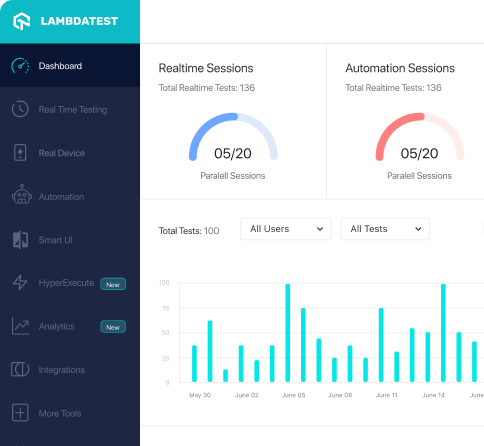How to use UpperBoundConstraint class of org.evomaster.dbconstraint package
Best EvoMaster code snippet using org.evomaster.dbconstraint.UpperBoundConstraint
Source:SqlConditionTranslator.java
...86 return new LowerBoundConstraint(tableName, columnName, value + 1);87 case GREATER_THAN_OR_EQUAL:88 return new LowerBoundConstraint(tableName, columnName, value);89 case LESS_THAN:90 return new UpperBoundConstraint(tableName, columnName, value - 1);91 case LESS_THAN_OR_EQUAL:92 return new UpperBoundConstraint(tableName, columnName, value);93 default:94 throw new UnsupportedOperationException(UNEXPECTED_COMPARISON_OPERATOR_MESSAGE + e.getSqlComparisonOperator());95 }96 } else if (rightLiteral instanceof SqlStringLiteralValue) {97 SqlStringLiteralValue stringLiteralValue = (SqlStringLiteralValue) rightLiteral;98 if (e.getSqlComparisonOperator().equals(EQUALS_TO)) {99 return new EnumConstraint(tableName, columnName, Collections.singletonList(stringLiteralValue.getStringValue()));100 } else {101 throw new UnsupportedOperationException(UNEXPECTED_COMPARISON_OPERATOR_MESSAGE + e.getSqlComparisonOperator());102 }103 } else {104 throw new UnsupportedOperationException("Unsupported literal " + rightLiteral);105 }106 }107 private TableConstraint visit(SqlLiteralValue leftLiteral, SqlComparisonCondition e, SqlColumn rightColumn) {108 if (leftLiteral instanceof SqlBigIntegerLiteralValue) {109 long value = ((SqlBigIntegerLiteralValue) leftLiteral).getBigInteger().longValue();110 final String tableName = getTableName(rightColumn);111 final String columnName = rightColumn.getColumnName();112 switch (e.getSqlComparisonOperator()) {113 case EQUALS_TO:114 return new RangeConstraint(tableName, columnName, value, value);115 case GREATER_THAN:116 return new UpperBoundConstraint(tableName, columnName, value - 1);117 case GREATER_THAN_OR_EQUAL:118 return new UpperBoundConstraint(tableName, columnName, value);119 case LESS_THAN:120 return new LowerBoundConstraint(tableName, columnName, value + 1);121 case LESS_THAN_OR_EQUAL:122 return new LowerBoundConstraint(tableName, columnName, value);123 default:124 throw new UnsupportedOperationException(UNEXPECTED_COMPARISON_OPERATOR_MESSAGE + e.getSqlComparisonOperator());125 }126 } else {127 throw new UnsupportedOperationException("Unsupported literal " + e.getSqlComparisonOperator());128 }129 }130 @Override131 public TableConstraint visit(SqlInCondition inExpression, Void argument) {132 SqlColumn column = inExpression.getSqlColumn();...UpperBoundConstraint
Using AI Code Generation
1TableConstraint constraint = new TableConstraint("constraint_name", "table_name");2constraint.addConstraint(new NotNullConstraint("column_name"));3constraint.addConstraint(new UniqueConstraint("column_name_1", "column_name_2"));4Table table = new Table("table_name");5table.addColumn(new Column("column_name", "varchar(255)"));6table.addColumn(new Column("column_name_1", "varchar(255)"));7table.addColumn(new Column("column_name_2", "varchar(255)"));8table.addConstraint(new TableConstraint("constraint_name", "table_name"));9table.addConstraint(new TableConstraint("constraint_name_1", "table_name"));UpperBoundConstraint
Using AI Code Generation
1val constraint = new UpperBoundConstraint("field", 100)2val constraint = new LowerBoundConstraint("field", 100)3val constraint = new BetweenConstraint("field", 100, 200)4val constraint = new InConstraint("field", List(1, 2, 3))5val constraint = new NotInConstraint("field", List(1, 2, 3))6val constraint = new IsNullConstraint("field")7val constraint = new IsNotNullConstraint("field")8val constraint = new LikeConstraint("field", "foo")9val constraint = new NotLikeConstraint("field", "foo")10val constraint = new AndConstraint(11 new LowerBoundConstraint("field1", 100), 12 new UpperBoundConstraint("field2", 200)UpperBoundConstraint
Using AI Code Generation
1public void testUpperBoundConstraint() throws Exception {2 String sql = "CREATE TABLE t1(id INTEGER, name TEXT)";3 runSql(sql);4 UpperBoundConstraint constraint = new UpperBoundConstraint("t1", "id", 5);5 String generatedSql = constraint.getSqlConstraint();6 assertEquals(generatedSql, "t1.id < 5");7}8public void testLowerBoundConstraint() throws Exception {9 String sql = "CREATE TABLE t1(id INTEGER, name TEXT)";10 runSql(sql);11 LowerBoundConstraint constraint = new LowerBoundConstraint("t1", "id", 5);12 String generatedSql = constraint.getSqlConstraint();13 assertEquals(generatedSql, "t1.id > 5");14}UpperBoundConstraint
Using AI Code Generation
1UpperBoundConstraint constraint = new UpperBoundConstraint("salary", 1000);2Table table = new Table("employee");3table.addConstraint(constraint);4Schema schema = new Schema();5schema.addTable(table);6Database database = new Database();7database.addSchema(schema);8DatabaseManager databaseManager = new DatabaseManager();9databaseManager.addDatabase(database);10DatabaseConstraintExtractor databaseConstraintExtractor = new DatabaseConstraintExtractor();11databaseConstraintExtractor.setDatabaseManager(databaseManager);12List<String> constraints = databaseConstraintExtractor.extractConstraints("mysql");13table.removeConstraint(constraint);14schema.removeTable(table);15database.removeSchema(schema);16databaseManager.removeDatabase(database);17databaseConstraintExtractor.setDatabaseManager(null);18databaseConstraintExtractor = null;Automation Testing Tutorials
Learn to execute automation testing from scratch with LambdaTest Learning Hub. Right from setting up the prerequisites to run your first automation test, to following best practices and diving deeper into advanced test scenarios. LambdaTest Learning Hubs compile a list of step-by-step guides to help you be proficient with different test automation frameworks i.e. Selenium, Cypress, TestNG etc.
LambdaTest Learning Hubs:
- JUnit Tutorial
- TestNG Tutorial
- Webdriver Tutorial
- WebDriverIO Tutorial
- Protractor Tutorial
- Selenium 4 Tutorial
- Jenkins Tutorial
- NUnit Tutorial
- Jest Tutorial
- Playwright Tutorial
- Cypress Tutorial
- PyTest Tutorial
YouTube
You could also refer to video tutorials over LambdaTest YouTube channel to get step by step demonstration from industry experts.
Most used methods in UpperBoundConstraint
Try LambdaTest Now !!
Get 100 minutes of automation test minutes FREE!!


